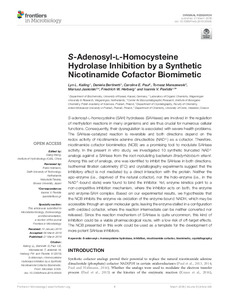Datum
2018-03-21Autor
Kailing, Lyn LisetteBertinetti, DanielaPaul, Caroline EmilieManszewski, TomaszJaskolski, MariuszHerberg, Friedrich W.Pavlidis, Ioannis V.Schlagwort
540 ChemieMetadata
Zur Langanzeige
Aufsatz
Artikel (Publikationen im Open Access gefördert durch die UB)

S-Adenosyl-L-Homocysteine Hydrolase Inhibition by a Synthetic Nicotinamide Cofactor Biomimetic
Zusammenfassung
S-adenosyl-L-homocysteine (SAH) hydrolases (SAHases) are involved in the regulation of methylation reactions in many organisms and are thus crucial for numerous cellular functions. Consequently, their dysregulation is associated with severe health problems. The SAHase-catalyzed reaction is reversible and both directions depend on the redox activity of nicotinamide adenine dinucleotide (NAD+) as a cofactor. Therefore, nicotinamide cofactor biomimetics (NCB) are a promising tool to modulate SAHase activity. In the present in vitro study, we investigated 10 synthetic truncated NAD+ analogs against a SAHase from the root-nodulating bacterium Bradyrhizobium elkanii. Among this set of analogs, one was identified to inhibit the SAHase in both directions. Isothermal titration calorimetry (ITC) and crystallography experiments suggest that the inhibitory effect is not mediated by a direct interaction with the protein. Neither the apo-enzyme (i.e., deprived of the natural cofactor), nor the holo-enzyme (i.e., in the NAD+-bound state) were found to bind the inhibitor. Yet, enzyme kinetics point to a non-competitive inhibition mechanism, where the inhibitor acts on both, the enzyme and enzyme-SAH complex. Based on our experimental results, we hypothesize that the NCB inhibits the enzyme via oxidation of the enzyme-bound NADH, which may be accessible through an open molecular gate, leaving the enzyme stalled in a configuration with oxidized cofactor, where the reaction intermediate can be neither converted nor released. Since the reaction mechanism of SAHase is quite uncommon, this kind of inhibition could be a viable pharmacological route, with a low risk of off-target effects. The NCB presented in this work could be used as a template for the development of more potent SAHase inhibitors.
Zitierform
In: Frontiers in microbiology. - Lausanne : Frontiers Media. - March 2018, Volume 9, Article 505Förderhinweis
Gefördert durch den Publikationsfonds der Universität KasselSammlung(en)
Publikationen (Fachgebiet Biochemie)Artikel (Publikationen im Open Access gefördert durch die UB)
Zitieren
@article{urn:nbn:de:hebis:34-2018082156236,
author={Kailing, Lyn Lisette and Bertinetti, Daniela and Paul, Caroline Emilie and Manszewski, Tomasz and Jaskolski, Mariusz and Herberg, Friedrich W. and Pavlidis, Ioannis V.},
title={S-Adenosyl-L-Homocysteine Hydrolase Inhibition by a Synthetic Nicotinamide Cofactor Biomimetic},
year={2018}
}
0500 Oax 0501 Text $btxt$2rdacontent 0502 Computermedien $bc$2rdacarrier 1100 2018$n2018 1500 1/eng 2050 ##0##urn:nbn:de:hebis:34-2018082156236 3000 Kailing, Lyn Lisette 3010 Bertinetti, Daniela 3010 Paul, Caroline Emilie 3010 Manszewski, Tomasz 3010 Jaskolski, Mariusz 3010 Herberg, Friedrich W. 3010 Pavlidis, Ioannis V. 4000 S-Adenosyl-L-Homocysteine Hydrolase Inhibition by a Synthetic Nicotinamide Cofactor Biomimetic / Kailing, Lyn Lisette 4030 4060 Online-Ressource 4085 ##0##=u http://nbn-resolving.de/urn:nbn:de:hebis:34-2018082156236=x R 4204 \$dAufsatz 4170 7136 ##0##urn:nbn:de:hebis:34-2018082156236
<resource xsi:schemaLocation="http://datacite.org/schema/kernel-2.2 http://schema.datacite.org/meta/kernel-2.2/metadata.xsd"> 2018-08-21T06:37:05Z 2018-08-21T06:37:05Z 2018-03-21 1664-302X urn:nbn:de:hebis:34-2018082156236 http://hdl.handle.net/123456789/2018082156236 Gefördert durch den Publikationsfonds der Universität Kassel eng Urheberrechtlich geschützt https://rightsstatements.org/page/InC/1.0/ S-adenosyl-L-homocysteine hydrolase inhibition nicotinamide cofactor biomimetic crystallography 540 S-Adenosyl-L-Homocysteine Hydrolase Inhibition by a Synthetic Nicotinamide Cofactor Biomimetic Aufsatz S-adenosyl-L-homocysteine (SAH) hydrolases (SAHases) are involved in the regulation of methylation reactions in many organisms and are thus crucial for numerous cellular functions. Consequently, their dysregulation is associated with severe health problems. The SAHase-catalyzed reaction is reversible and both directions depend on the redox activity of nicotinamide adenine dinucleotide (NAD+) as a cofactor. Therefore, nicotinamide cofactor biomimetics (NCB) are a promising tool to modulate SAHase activity. In the present in vitro study, we investigated 10 synthetic truncated NAD+ analogs against a SAHase from the root-nodulating bacterium Bradyrhizobium elkanii. Among this set of analogs, one was identified to inhibit the SAHase in both directions. Isothermal titration calorimetry (ITC) and crystallography experiments suggest that the inhibitory effect is not mediated by a direct interaction with the protein. Neither the apo-enzyme (i.e., deprived of the natural cofactor), nor the holo-enzyme (i.e., in the NAD+-bound state) were found to bind the inhibitor. Yet, enzyme kinetics point to a non-competitive inhibition mechanism, where the inhibitor acts on both, the enzyme and enzyme-SAH complex. Based on our experimental results, we hypothesize that the NCB inhibits the enzyme via oxidation of the enzyme-bound NADH, which may be accessible through an open molecular gate, leaving the enzyme stalled in a configuration with oxidized cofactor, where the reaction intermediate can be neither converted nor released. Since the reaction mechanism of SAHase is quite uncommon, this kind of inhibition could be a viable pharmacological route, with a low risk of off-target effects. The NCB presented in this work could be used as a template for the development of more potent SAHase inhibitors. open access In: Frontiers in microbiology. - Lausanne : Frontiers Media. - March 2018, Volume 9, Article 505 Kailing, Lyn Lisette Bertinetti, Daniela Paul, Caroline Emilie Manszewski, Tomasz Jaskolski, Mariusz Herberg, Friedrich W. Pavlidis, Ioannis V. doi:10.3389/fmicb.2018.00505 </resource>
Die folgenden Lizenzbestimmungen sind mit dieser Ressource verbunden:
Urheberrechtlich geschützt

